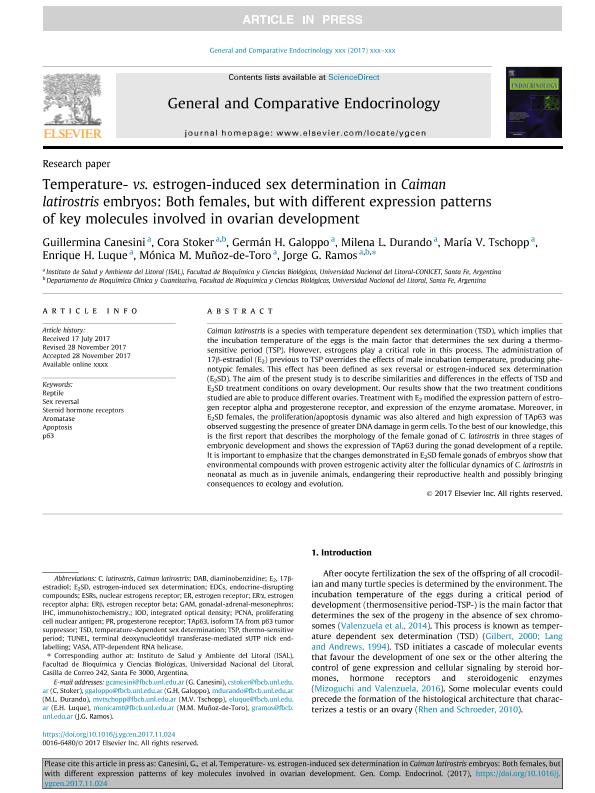Mostrar el registro sencillo del ítem
dc.contributor.author
Canesini, Guillermina

dc.contributor.author
Stoker, Cora

dc.contributor.author
Galoppo, Germán Hugo

dc.contributor.author
Durando, Milena de Lourdes

dc.contributor.author
Tschopp, María Virginia

dc.contributor.author
Luque, Enrique Hugo

dc.contributor.author
Muñoz de Toro, Monica Milagros

dc.contributor.author
Ramos, Jorge Guillermo

dc.date.available
2018-08-17T14:05:25Z
dc.date.issued
2018-04
dc.identifier.citation
Canesini, Guillermina; Stoker, Cora; Galoppo, Germán Hugo; Durando, Milena de Lourdes; Tschopp, María Virginia; et al.; Temperature- vs. estrogen-induced sex determination in Caiman latirostris embryos: Both females, but with different expression patterns of key molecules involved in ovarian development; Academic Press Inc Elsevier Science; General and Comparative Endocrinology; 259; 4-2018; 176-188
dc.identifier.issn
0016-6480
dc.identifier.uri
http://hdl.handle.net/11336/56082
dc.description.abstract
Caiman latirostris is a species with temperature dependent sex determination (TSD), which implies that the incubation temperature of the eggs is the main factor that determines the sex during a thermo-sensitive period (TSP). However, estrogens play a critical role in this process. The administration of 17β-estradiol (E2) previous to TSP overrides the effects of male incubation temperature, producing phenotypic females. This effect has been defined as sex reversal or estrogen-induced sex determination (E2SD). The aim of the present study is to describe similarities and differences in the effects of TSD and E2SD treatment conditions on ovary development. Our results show that the two treatment conditions studied are able to produce different ovaries. Treatment with E2 modified the expression pattern of estrogen receptor alpha and progesterone receptor, and expression of the enzyme aromatase. Moreover, in E2SD females, the proliferation/apoptosis dynamic was also altered and high expression of TAp63 was observed suggesting the presence of greater DNA damage in germ cells. To the best of our knowledge, this is the first report that describes the morphology of the female gonad of C. latirostris in three stages of embryonic development and shows the expression of TAp63 during the gonad development of a reptile. It is important to emphasize that the changes demonstrated in E2SD female gonads of embryos show that environmental compounds with proven estrogenic activity alter the follicular dynamics of C. latirostris in neonatal as much as in juvenile animals, endangering their reproductive health and possibly bringing consequences to ecology and evolution.
dc.format
application/pdf
dc.language.iso
eng
dc.publisher
Academic Press Inc Elsevier Science

dc.rights
info:eu-repo/semantics/openAccess
dc.rights.uri
https://creativecommons.org/licenses/by-nc-sa/2.5/ar/
dc.subject
Apoptosis
dc.subject
Aromatase
dc.subject
P63
dc.subject
Reptile
dc.subject
Sex Reversal
dc.subject
Steroid Hormone Receptors
dc.subject.classification
Otras Ciencias Biológicas

dc.subject.classification
Ciencias Biológicas

dc.subject.classification
CIENCIAS NATURALES Y EXACTAS

dc.title
Temperature- vs. estrogen-induced sex determination in Caiman latirostris embryos: Both females, but with different expression patterns of key molecules involved in ovarian development
dc.type
info:eu-repo/semantics/article
dc.type
info:ar-repo/semantics/artículo
dc.type
info:eu-repo/semantics/publishedVersion
dc.date.updated
2018-08-16T17:21:25Z
dc.journal.volume
259
dc.journal.pagination
176-188
dc.journal.pais
Países Bajos

dc.journal.ciudad
Amsterdam
dc.description.fil
Fil: Canesini, Guillermina. Consejo Nacional de Investigaciones Científicas y Técnicas. Centro Científico Tecnológico Conicet - Santa Fe. Instituto de Salud y Ambiente del Litoral. Universidad Nacional del Litoral. Instituto de Salud y Ambiente del Litoral; Argentina
dc.description.fil
Fil: Stoker, Cora. Consejo Nacional de Investigaciones Científicas y Técnicas. Centro Científico Tecnológico Conicet - Santa Fe. Instituto de Salud y Ambiente del Litoral. Universidad Nacional del Litoral. Instituto de Salud y Ambiente del Litoral; Argentina. Universidad Nacional del Litoral. Facultad de Bioquímica y Ciencias Biológicas; Argentina
dc.description.fil
Fil: Galoppo, Germán Hugo. Consejo Nacional de Investigaciones Científicas y Técnicas. Centro Científico Tecnológico Conicet - Santa Fe. Instituto de Salud y Ambiente del Litoral. Universidad Nacional del Litoral. Instituto de Salud y Ambiente del Litoral; Argentina
dc.description.fil
Fil: Durando, Milena de Lourdes. Consejo Nacional de Investigaciones Científicas y Técnicas. Centro Científico Tecnológico Conicet - Santa Fe. Instituto de Salud y Ambiente del Litoral. Universidad Nacional del Litoral. Instituto de Salud y Ambiente del Litoral; Argentina
dc.description.fil
Fil: Tschopp, María Virginia. Consejo Nacional de Investigaciones Científicas y Técnicas. Centro Científico Tecnológico Conicet - Santa Fe. Instituto de Salud y Ambiente del Litoral. Universidad Nacional del Litoral. Instituto de Salud y Ambiente del Litoral; Argentina
dc.description.fil
Fil: Luque, Enrique Hugo. Consejo Nacional de Investigaciones Científicas y Técnicas. Centro Científico Tecnológico Conicet - Santa Fe. Instituto de Salud y Ambiente del Litoral. Universidad Nacional del Litoral. Instituto de Salud y Ambiente del Litoral; Argentina
dc.description.fil
Fil: Muñoz de Toro, Monica Milagros. Consejo Nacional de Investigaciones Científicas y Técnicas. Centro Científico Tecnológico Conicet - Santa Fe. Instituto de Salud y Ambiente del Litoral. Universidad Nacional del Litoral. Instituto de Salud y Ambiente del Litoral; Argentina
dc.description.fil
Fil: Ramos, Jorge Guillermo. Consejo Nacional de Investigaciones Científicas y Técnicas. Centro Científico Tecnológico Conicet - Santa Fe. Instituto de Salud y Ambiente del Litoral. Universidad Nacional del Litoral. Instituto de Salud y Ambiente del Litoral; Argentina. Universidad Nacional del Litoral. Facultad de Bioquímica y Ciencias Biológicas; Argentina
dc.journal.title
General and Comparative Endocrinology

dc.relation.alternativeid
info:eu-repo/semantics/altIdentifier/doi/https://dx.doi.org/10.1016/j.ygcen.2017.11.024
dc.relation.alternativeid
info:eu-repo/semantics/altIdentifier/url/https://www.sciencedirect.com/science/article/pii/S0016648017305087
Archivos asociados
